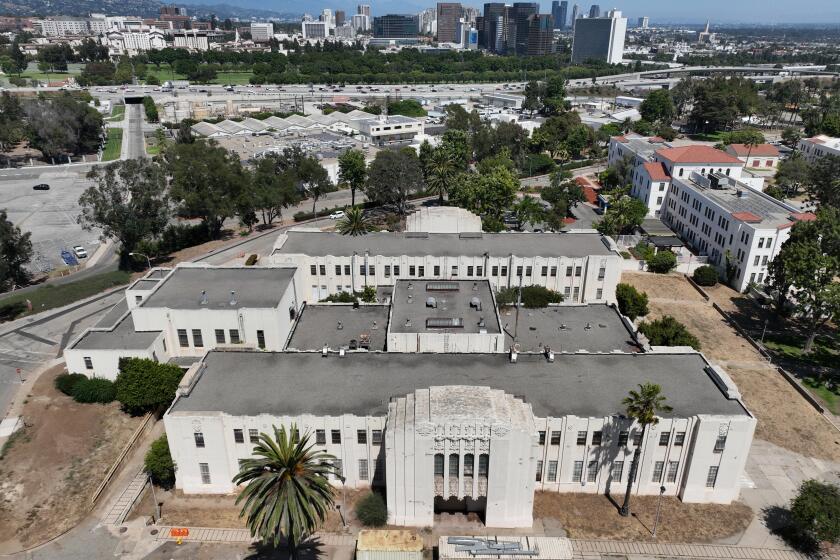A co-response unit might have made a difference in Isla Vista
Earlier this year, when a friend of mine made what was perceived as a physical threat to a neighbor, it wasn’t just the police who responded.
His case managers at Housing Works in Hollywood contacted a special unit that consists of both LAPD officers and county mental health workers. One of those teams paid a visit to my friend, who suffers from schizophrenia, and evaluated him. The result was that instead of ending up in jail, or left alone at risk to himself or others, he was hospitalized. He’s still undergoing treatment and is much improved, and is still being monitored by the team that responded initially.
I bring this up because of the Isla Vista case, in which a 22-year-old man who had been in therapy for years went on a rampage May 23, killing six people and injuring 13 others. Three weeks earlier, on April 30, concerns about the mental state of Elliot Rodger were handled differently than a similar call might have been handled in Los Angeles County.
Santa Barbara County doesn’t have co-response units like the one that responded to my friend’s crisis. And the same is true for most counties in California, as well as the rest of the country. L.A. County has 37 such units — with 11 more planned — operating in conjunction with the LAPD, the Sheriff’s Department and other law enforcement agencies. While these approaches aren’t foolproof, given the complexities of mental illness, their success has drawn interest from around the country.
Santa Barbara County’s Alcohol, Drug and Mental Health Services Department was slammed last year by consultants who called mental health services deficient, disconnected and dysfunctional. Takashi Wada, the interim director, told me the department had been working on improvements, including greater collaboration with law enforcement. And an anticipated increase in state mental health funding may well be invested in co-response units, a member of Wada’s staff told me.
In the Isla Vista case, a county mental health staffer became concerned about Rodger based on issues raised by the young man’s mother and a friend. The staffer called police, who went to Rodger’s apartment for a so-called welfare check on April 30. They were concerned enough, based on a past encounter with Rodger, to send four sheriff’s deputies, a UC Santa Barbara police officer and a dispatcher in training. They found Rodger to be “shy, timid and polite.”
“When questioned by the deputies about reported disturbing videos he had posted online, Rodger told them he was having trouble fitting in socially in Isla Vista and the videos were merely a way of expressing himself,” the Santa Barbara County Sheriff’s Department said in a statement issued last week.
“Based on the information available to them at the time, sheriff’s deputies concluded that Rodger was not an immediate threat to himself or others, and that they did not have cause to place him on an involuntary mental health hold or … search his residence. Therefore, they did not view the videos or conduct a weapons check on Rodger.”
Rodger himself later wrote about that encounter, saying he “tactfully told them it was all a misunderstanding, and they finally left. If they had demanded to search my room … that would have ended everything.”
In hindsight, it’s easy to argue that the police should have done more. But the law is written to balance public safety against civil liberties, and when it comes to mental health, evaluations are complicated and imperfect. I don’t know whether Rodger had been diagnosed with a specific disorder, but people who are seriously ill aren’t always in acute stages, and even when they are, they can sometimes “present” well enough to be deemed OK.
Which is all the more reason to have mental health professionals on the scene along with police, or to at least consult them, even if the police have crisis training.
“There’s a tremendous benefit in co-response teams,” said Tony Beliz, who helped establish and lead many such teams until his recent retirement from the L.A. County Department of Mental Health. Beliz, now a consultant, said a clinician has insights and techniques police don’t have, and is sometimes able to establish rapport and get consent to search a home for any signs of trouble.
Beliz said that in 2007, after the Virginia Tech massacre in which a disturbed student killed 32 people, the LAPD asked Beliz to help design a co-response team devoted to preventing violence on school campuses. About a dozen clinicians work with police in responding to reports of potential problems and providing referrals and follow-up monitoring.
The city of Burbank has a co-response unit Beliz helped establish with Capt. Michael Albanese. Albanese had previously been the LAPD SWAT commander for decades, and he says roughly a third of the SWAT incidents involved people whose crisis had a mental health underpinning. When he got to Burbank in 2010, he studied department statistics and noticed “a huge annual uptick” in mental health-related service calls, attempted suicides and police use of force during involuntary commitments.
Together with Beliz, he designed a co-response unit. Since its inception, Albanese said, the number of such incidents has leveled off after four years of large increases. That may be partly because the team tries to find the best placement for mental health care, Albanese said, and then follows up to make sure the clients are still getting the help they need.
When it comes to mental health, the complexities are many and the cures too few. But we have some good models for making a difference, and Isla Vista is a tragic reminder of the need to commit to them fully.
More to Read
Sign up for Essential California
The most important California stories and recommendations in your inbox every morning.
You may occasionally receive promotional content from the Los Angeles Times.










